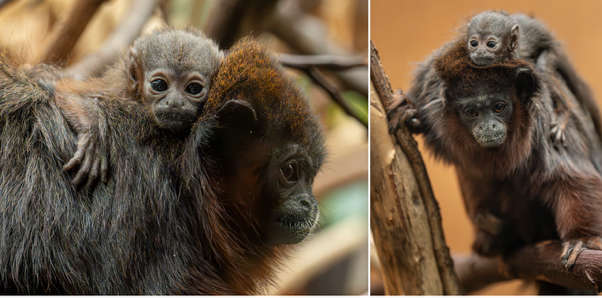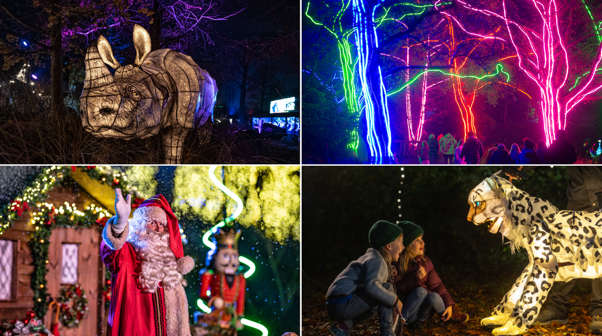
Conservationists are celebrating the birth of a rare coppery titi monkey at Chester Zoo - the first of its kind to be born at the conservation charity in 94 years.
Zookeepers spotted the baby clinging to the back of its parents during their early morning checks.
It’s the first time one of the rare South American monkeys has ever been born at the zoo, following on from the arrival of parents Scout and Ned in March. The pair are a key part of an international conservation breeding programme that’s working to safeguard the species.
The tiny youngster, described as the ‘size of a golf ball,’ will grow to stand at around 30cm tall once fully developed.
Native to South America where they play an important role in dispersing seeds and maintaining healthy rainforests, coppery titi monkeys face major threats to their survival. Deforestation, hunting for bushmeat and the illegal wildlife trade are causing populations to decline according to The International Union for Nature (IUCN), the world’s leading authority on the state of nature.
Zookeepers say the baby will soon start to branch out and begin to explore on its own, which is when they’ll discover if it’s male or female.
Holly Webb, Primate Keeper at Chester Zoo, said:
“It’s always a joy to welcome any new addition, but the birth of the very first coppery titi monkey here at Chester Zoo is an extra special moment. Right now, the baby is no bigger than a golf ball - but it’s bright-eyed, healthy and already full of confidence, clinging tightly as mum and dad as they leap through the treetops.
“One of the most fascinating things about titi monkeys is their parenting behaviour, with dads playing a really active role in raising their young. It’s dad Ned who is doing most of the carrying, while mum Scout steps in for nursing and to give Ned a well-earned rest. With the baby still so tiny and tucked firmly into its parents’ fur, it’ll be a few more weeks until it begins to explore on its own. Once it starts venturing out, we’ll be able to determine whether it’s male or female and then choose the perfect name for this precious new arrival.
“Their strong co-parenting bond, alongside their incredible social lives and small stature, is what makes this species so incredibly fascinating. But they face an uncertain future in the wild, with increasing pressures from logging and the illegal pet trade. We’re hopeful though, that this family unit will grow over time and continue to play a vital role in the conservation breeding programme that’s safeguarding the species.”
Coppery titi monkeys are known for their striking red fur and bushy tails, as well as their lifelong pair bonds. They are monogamous and are renowned for their loud vocalisations -performed at dawn by male and female pairs to mark their territory.
Coppery titi monkey facts:
- The baby was born on 14 August 2025
- Latin name: (Plecturocebus cupreus)
- Habitat: Native to South America’s rainforests, particularly in Peru and Brazil.
- Named for their striking red, fluffy fur, bushy tails, and grey faces with small flat noses.
- Monogamous primates that form lifelong pairs and are known for daily dawn “duets” to mark territory.
- Strong social bonds: pairs are often seen grooming, cuddling and intertwining tails.
- Dads play the biggest role in childcare, carrying infants on their backs for up to six months.
- Long tails are not prehensile (cannot grasp or hold).
- Play a vital role in rainforest biodiversity as seed dispersers.
- Newborns are tiny - around the size of a golf ball - and adults reach around 40cm tall (plus a tail almost the same length).
Pictured - Conservationists are celebrating the first coppery titi monkey to be born at Chester Zoo in its 94-year history.


 Chester Zoo’s spectacular Christmas light trail is returning this winter
Chester Zoo’s spectacular Christmas light trail is returning this winter
 The Duke of Westminster returned to Eccleston Primary School to celebrate its 150th anniversary
The Duke of Westminster returned to Eccleston Primary School to celebrate its 150th anniversary
 Olympic legend to start Chester Marathon
Olympic legend to start Chester Marathon
 Cheshire leaders welcome green light for trailblazing carbon capture project
Cheshire leaders welcome green light for trailblazing carbon capture project
 Funding secured to resurface B5125 Broughton
Funding secured to resurface B5125 Broughton
 FA Cup Report: Chester FC 5 - 1 Curzon Ashton
FA Cup Report: Chester FC 5 - 1 Curzon Ashton
 Partial closure orders granted for three Chester properties
Partial closure orders granted for three Chester properties
 The Festival of Diwali in Chester
The Festival of Diwali in Chester
 Flint man jailed for attempting to smuggle drugs into Cheshire music festival
Flint man jailed for attempting to smuggle drugs into Cheshire music festival
 Flint RNLI receives donation following abseil fundraising challenge
Flint RNLI receives donation following abseil fundraising challenge
 Seven years of ‘Food and Fun’ in Flintshire
Seven years of ‘Food and Fun’ in Flintshire
 Chester and Wirral Football League - Latest Results
Chester and Wirral Football League - Latest Results
 Police appeal to trace wanted Cheshire man
Police appeal to trace wanted Cheshire man
 Flintshire secures £5 million for highway improvements
Flintshire secures £5 million for highway improvements
 MP hits out at Barclays over Ellesmere Port closure
MP hits out at Barclays over Ellesmere Port closure
 Green Gym in Ellesmere Port
Green Gym in Ellesmere Port
 Local MP Welcomes £20 Million Investment to Transform Ellesmere Port
Local MP Welcomes £20 Million Investment to Transform Ellesmere Port
 Flintshire Schools become Eco Champions
Flintshire Schools become Eco Champions
 Appeal for information following e-bike robberies in Ellesmere Port
Appeal for information following e-bike robberies in Ellesmere Port
Comments
Add a comment